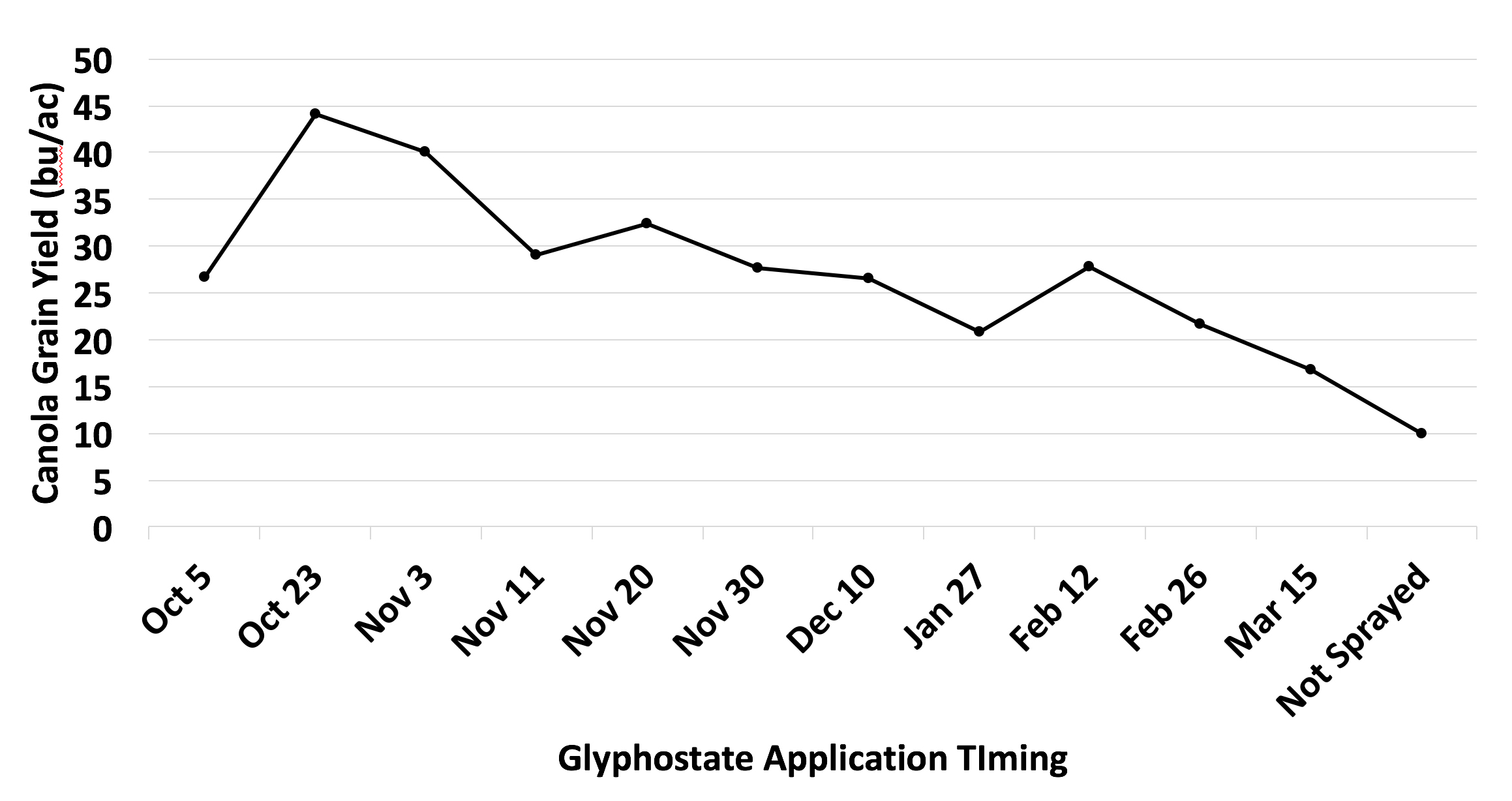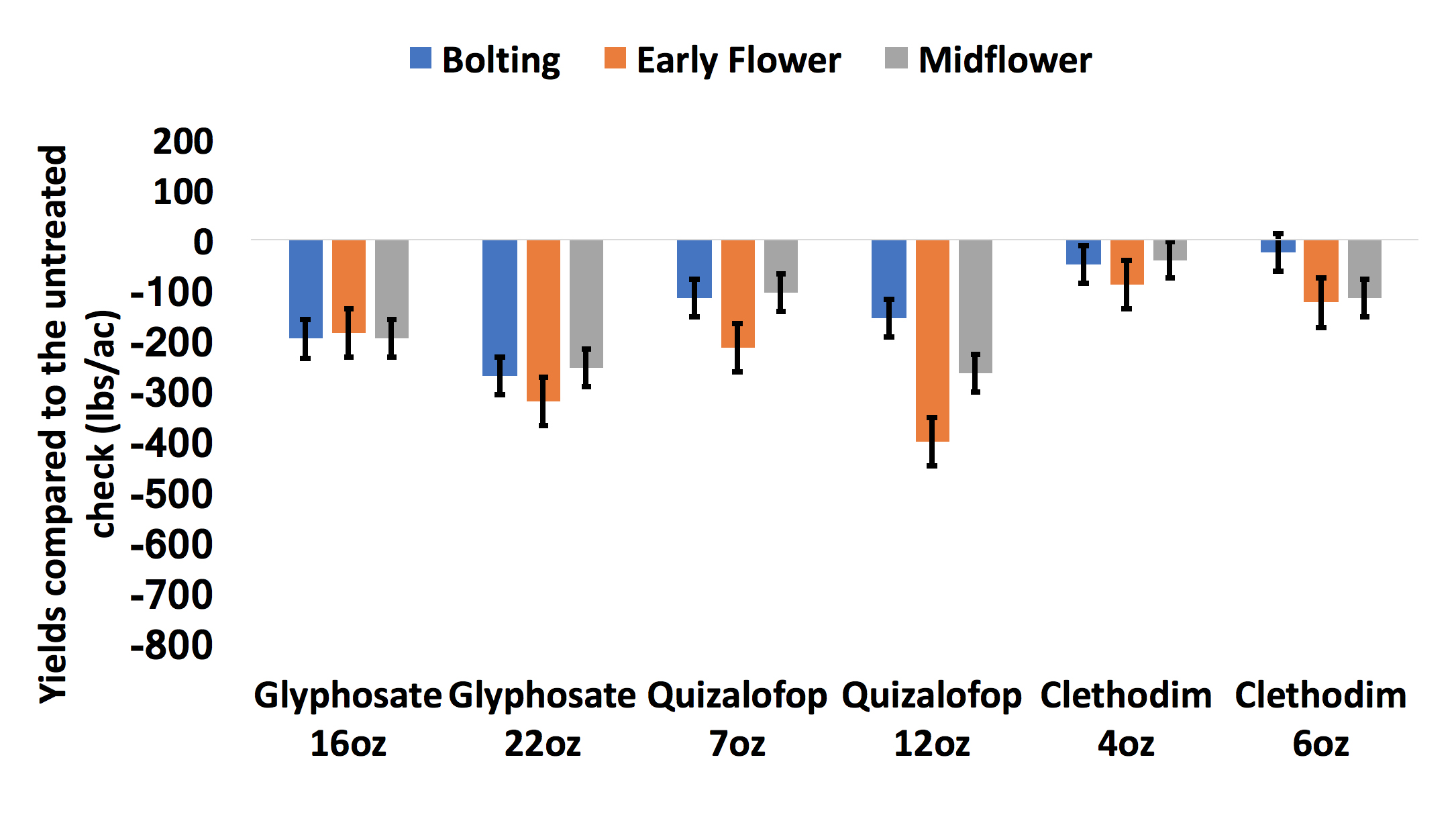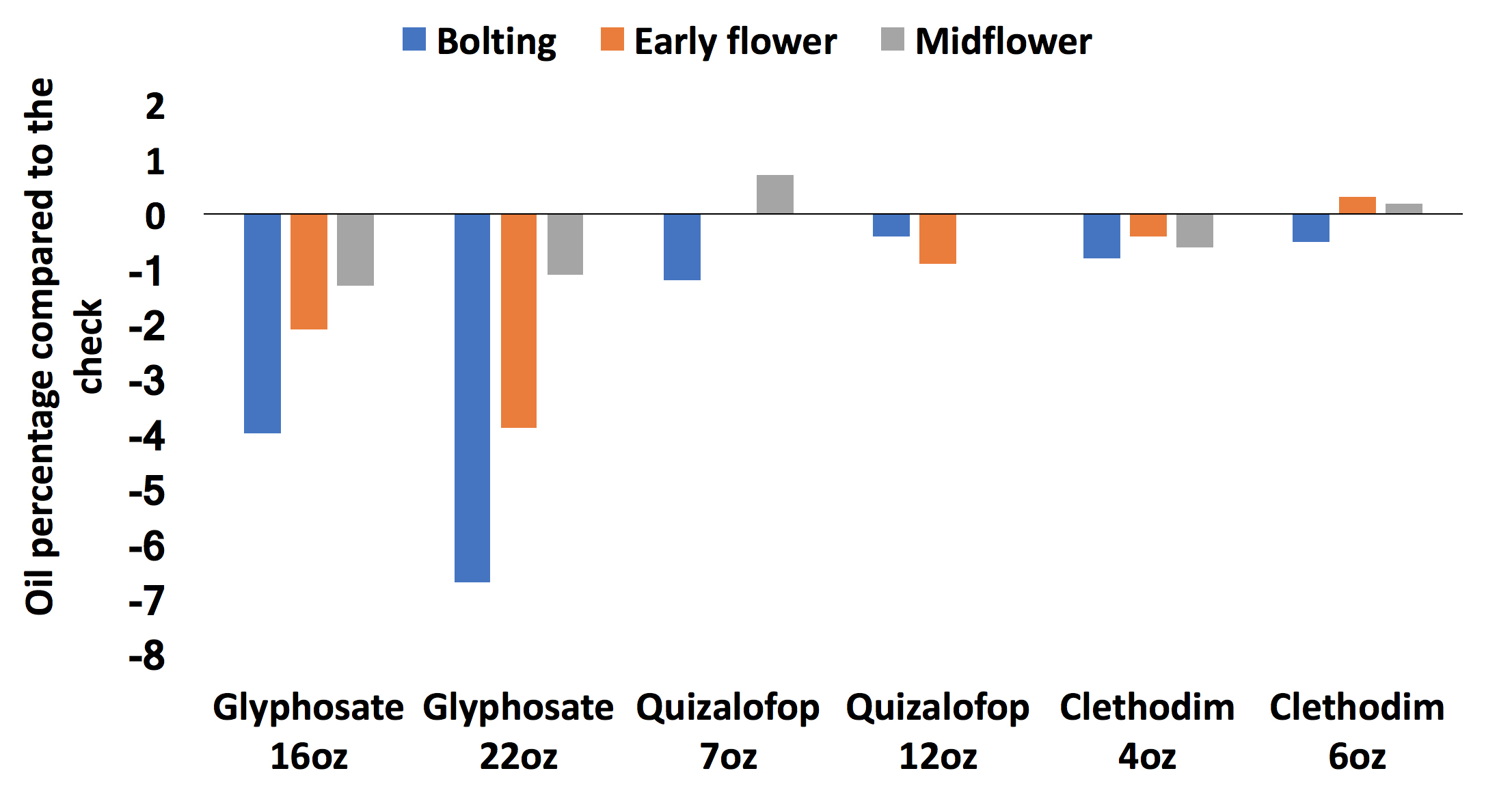Importance of Herbicide Application Timing on Winter Canola
The Weed Problem
Wheat has been a staple of Oklahoma agriculture for several decades. However, wheat in Oklahoma has typically been grown in continuous monoculture for a majority of these years. Monocrop production (or growing the same crop year after year) has many negative consequences, such as lower quality seed, diminished or stagnant yields and high weed incidence and pressure. High weed pressure in Oklahoma wheat systems is the primary concern because weeds can greatly decrease yield and quality as well as increase harvest dockage, resulting in decreased return on each harvested acre. Weed pressure is largely dominated by winter annual grassy weeds, such as feral rye, Itialian ryegrass, jointed goatgrass, wild oats and various brome species (cheat, rescuegrass, downy brome, etc.). Managing these weed species is a major challenge in winter wheat production, as there are few targeted herbicides that can be applied in-season, and options are becoming fewer with herbicide resistance. Therefore, management practices must be developed to overcome this issue.
Managing the Weed Problem
Clearfield® wheat varieties have been established in recent years, allowing producers to apply Beyond® (imazamox) over the top of wheat to control both problematic grassy and broadleaf weeds. The one-gene Clearfield® system can help suppress feral rye and control jointed goatgrass. Feral rye can be effectively controlled using a two-gene Clearfield® system including fall applications of Beyond® with recommended rates of MSO, followed by a spring application to catch stragglers. The seed and chemistry required for the system bear some elevated costs, which can provide a challenge for many producers in Oklahoma. However, this system can reduce some of our problematic grassy weed populations if used properly.
An alternative to this system is to integrate crop rotation, rotating winter wheat with other crops, into the system. While many summer crops have their benefit, winter canola can be an ideal rotational crop for winter wheat. Winter canola is a winter annual broadleaf and follows a very similar growth and management pattern of winter wheat (for further information on canola growth and management, please refer to PSS-2130- Managing Winter Canola in Oklahoma). The major benefit of rotating winter canola with winter wheat is the ability to utilize different herbicide modes of action.
Rotating crops and rotating herbicides are the preferred method to combat herbicide-resistant weeds. Acetolactate Synthase (ALS) inhibiting herbicides for winter wheat were introduced in the region about 30 years ago and have been heavily used since then to control some broadleaf weeds and many of the winter annual grassy weeds. Some populations of ryegrass and cheat have been documented as ALS-resistant in the region, partially due to the heavy use of this family of herbicides. Rotating from a grass crop to a broadleaf crop will increase herbicide options.
In-season Canola and Weed Control
After establishment, winter canola can be quite competitive with winter annual weeds in late fall. As canola is grown by many to help with weed control, not controlling weed populations will not only limit the viability of canola for many Oklahoma producers, but fail to cleanup fields for proceeding crops. Many herbicides are quite effective at managing winter annual grassy weeds and can be applied over the top of canola. It is imperative to apply herbicides in a timely fashion to achieve satisfactory weed control and to not harm the canola crop itself. There are two main ways that application timing can influence the canola crop, first is reduced yield potential due to excessive weed competition and the other is crop injury from the herbicide.
In the fall, it is best to apply herbicides before canopy closure to obtain adequate
coverage of the herbicides on the weeds. Recent research at Oklahoma State University
has shown that the optimal fall herbicide application timing is about four weeks after
planting canola to maximize grain yield. Applications made from early November to
mid-March averaged seed yield reductions of 1.33 bushels per acre per week of following
the optimal application timing (Figure 1). In the spring, it is best to apply herbicides
once weeds break dormancy and start to actively grow, but prior to the canola reaching
the bolting stage. During early spring, many growers will target fields to have an
additional herbicide application to minimize the presence and pressure of grassy weeds.
Some of these weed populations either escaped the first application in the fall or
emerged after the fall application.
Figure 1. Influence of a single glyphosate application timing on canola grain yield due to prolonged weed competition of a heavy infestation of Italian ryegrass and volunteer wheat.
While early spring applications are considered a viable and effective management practice, sometimes the crop will reach the bolting stage earlier than expected or environmental conditions can limit the ability of grower to make a timely application. While these applications can provide some control, removing these weeds earlier in the spring will not only provide superior control, but data from other regions and in other crops have shown that waiting until reproductive growth can result in diminished yield and seed quality. Additionally, the application of many of these herbicides after bolting are off-label and cannot be legally used within winter canola systems in Oklahoma. Growers should consult all labels before making any application in the spring, especially after bolting has started.
Will Late-season Herbicides Hurt Canola Yields?
To determine the impact of topical applications of various herbicides during reproductive grown on canola performance, a study was established in 2014-2015 and 2015-2016 at the Cimarron Research Station in Perkins, OK. Three different commonly applied canola herbicides (RoundUp Powermax® – glyphosate; Assure® II – quizalofop; and Select® – clethodim) were applied at bolting, early flower and midflower. Yields and seed quality were used to determine the effect of these herbicides on winter canola production. Weed control of these applications were noted, but not specifically measured.
Generally, herbicide applications during reproductive growth stages have had a negative impact on canola yield and oil content. Glyphosate applications generally had the greatest negative impact on yields, with yield declines as great as nearly 700 pounds per acre (14 bushels, a 33 percent yield decline) when using the high application rate (22 ounces per acre) at early flower in 2015-2016. Quizalofop applications generally reduced yields, but the effect was highly variable. In the 2014-2015 season, yield declines were substantial, especially during flowering, resulting in nearly a 400-pound per acre decrease (20 percent yield decline). However, in the 2015-2016 season, quizalofop applications only slightly decreased yields across all application timings. The application of clethodim only slightly decreased yields in both the 2014-2015 and 2015-2016 seasons; however, no applications reached a significant yield decline. The response of winter canola to herbicide applications was somewhat variable across application years; however, most resulted in declining yields compared to non-treated control (Figure 2).
Figure 2. Canola grain yields for glyphosate, quizalofop and clethodim applications at bolting, early flower and mid-flower compared to the untreated controlling 2014-2015 (top) and 2015-2016 (bottom) seasons.
Oil content is the most critical factor to the sale and marketing of canola after harvest. Critical oil content for seed is 38 percent; below this point, growers can expect price declines. In addition to yield, herbicide applications affected oil content, but not to the degree that yield was affected. Glyphosate applications, especially at bolting and early flower caused a significant decline in oil content. All other herbicide applications did not influence oil content compared to the non-treated control (Figure 3).
Figure 3. Canola oil content for glyphosate, quizalofop and clethodim applications at bolting, early season and mid-flower compared to the untreated control in 2015-2016.
Summary
One of the greatest benefits of canola is how effective weed management can result in successful control of problematic grassy weeds in the following winter wheat system. The best time to control these problematic weeds is in the fall, but spring applications can still be made prior to reproductive growth of the canola plant. However, some springs do not allow growers to quickly and effectively apply herbicides to their canola in a timely manner, which has resulted in rare incidences of late-season herbicide applications. Based on initial studies, it does indicate that these late-season herbicide applications can negatively influence canola yield and oil content. This makes these applications a high risk with potentially minimal reward. In addition, it must be stressed that many herbicides used by growers for these later spring applications are off label and cannot be used for application after bolting. As a large portion of the canola grown in the state is used for human consumption, agencies regulating these label restrictions will provide little to no forgiveness for off-label applications. Therefore, it is best to ensure enough time is dedicated to making these herbicide applications prior to bolting to achieve adequate weed control without decreasing yield potential.

Appreciation is extended to Southern Extension Risk Management Education for financial support of research.
Josh Lofton
Cropping Systems Specialist
Josh Bushong
Extension Agronomist, Northwest District
Misha Manuchehri
Extension Weed Science




